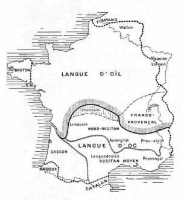The literary tradition

The decline of the written language coincides with the Albigensian Crusade, the military campaign initiated by the Catholic Church to eliminate the Cathar heresy in Languedoc, between the 13th and 14th century. The Crusade resulted into a realignment of Occitania into the sphere of Paris and, in 1539, led to the Ordinance of Villers-Cotterêts, issued by Francis I, that imposed the use of French in administrative documents. Occitan thus disappeared from written usage, turned into a vernacular language (patois) and, little by little, lost its graphic standard.
The 19th century witnessed a strong revival of Provençal (a regional variant of Occitan) in literature, largely thanks to poet Frédéric Mistral (1830-1914). Mistral’s most important work is Miréio (1859), poem consisting of twelve songs. Together with other Provençal intellectuals, Mistral founded Félibrige, a literary and cultural association, promoting still today Occitan language and culture. He was awarded the Nobel Prize for Literature in 1904.
During the 20th century, a linguistic norm was created (known as classical) based on the medieval troubadour tradition, in contrast with that adopted by the Félibrige of Mistral (the Mistralian norm) which was based on modern French orthography. The result was a standard normalized Occitan that respects and admits soft regional adaptations, understood from Alps to Pyrenees. Today, this normalized Occitan is employed in the associative bilingual Occitan-French schools, the calandretas, in radio and TV programs (France 3), in newspaper and web publications promoted by cultural association (Institut d’Estudis Occitans - IEO, Chambra d’Òc) and in public authorities, such as Piedmont Region (Italy) and Generalitat de Catalunya (Spain). In order to see recognized internationally the importance of Occitan and to guarantee its preservation even without a political unity of its territory, Occitan has recently been proposed to be classified as an Intangible Heritage of Humanity by the UNESCO.
In Italy, the Occitan-speaking community is recognized and protected by the state law 482/1999.
Today, there are several poets and writers employing the Òc language throughout the whole Occitania and also in the Piedmontese valleys.
commenta